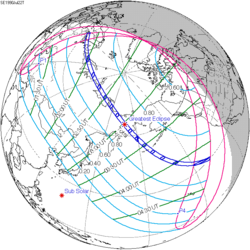| Partial eclipse | |
| Gamma | 1.105 |
|---|---|
| Magnitude | 0.7758 |
| Maximum eclipse | |
| Coordinates | 63°24′N45°18′W / 63.4°N 45.3°W |
| Times (UTC) | |
| Greatest eclipse | 17:37:12 |
| References | |
| Saros | 122 (54 of 70) |
| Catalog # (SE5000) | 9391 |
A partial solar eclipse occurred at the Moon's descending node of orbit on Saturday, November 23, 1946, [1] with a magnitude of 0.7758. A solar eclipse occurs when the Moon passes between Earth and the Sun, thereby totally or partly obscuring the image of the Sun for a viewer on Earth. A partial solar eclipse occurs in the polar regions of the Earth when the center of the Moon's shadow misses the Earth.
Contents
- Eclipse details
- Eclipse season
- Related eclipses
- Eclipses in 1946
- Metonic
- Tzolkinex
- Half-Saros
- Tritos
- Solar Saros 122
- Inex
- Triad
- Solar eclipses of 1946–1949
- Saros 122
- Metonic series
- Tritos series
- Inex series
- References
- External links
This was the last of four partial solar eclipses in 1946, with the others occurring on January 3, May 30, and June 29.
A partial eclipse was visible for parts of Canada, the United States, the Caribbean, and northern South America.






































































































